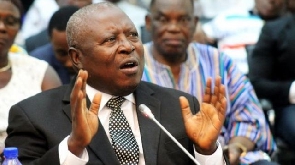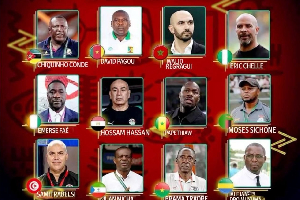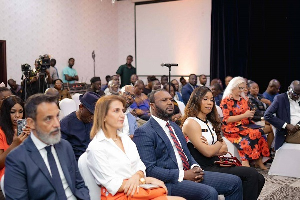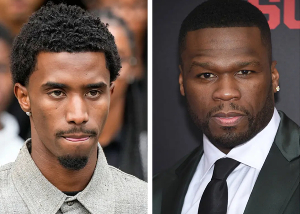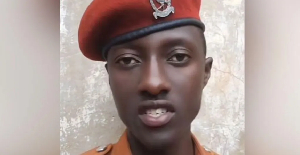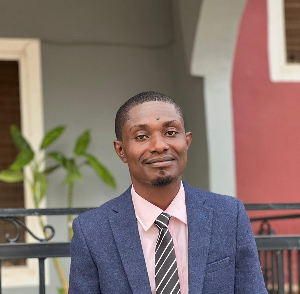The African Concept of the Arts Being Central to Life.
By the year 2005, Ghana should be implementing fully the free compulsory Universal Basic Education(fCUBE) for its school-going age children. In Ghana, basic education comprises six years of Primary School and three years of Junior Secondary School.
The implementation of the fCUBE program will require the services of a large number of well-qualified teachers in the shortest possible time. According to the Policy Document on Basic Education Sector improvement Program issued by the Ministry of Education in Ghana, “ the teachers should be well-versed in teaching, particularly in primary methodology. Teachers should be developed to fulfill the desired roles in the fCUBE program” 1 There is therefore a revised teacher preparation program for Teacher Training Colleges (TTCs) selected to do primary Education.
Unfortunately, the new curriculum for TTCs offering Primary Education has very little of the arts (especially Visual Art) This situation in my country’s teacher education reform program reminds me of Professor Elliot W.Eisner’s article in which he questions American reform agenda for their schools for 2000 in which the arts absent. I agree with professor Eisher with his assertion in that article that “prevailing conceptions of the arts are based on massive misunderstanding of the role of the arts in human development and education. This misunderstanding is rooted in ancient conceptions of mind, knowledge, and intelligence. Collectively, these conceptions impoverish the programs of schools and the education of the young.”2 How often have some educators and curriculum planners considered the Visual Arts as less intellectual in the education of the child and have denied the arts their rightful role in our education enterprise!
This paper is therefore an innovative argument for the (Visual) Arts as an effective teaching and learning strategy in our schools. It is also my contribution to the efforts for making Art a core subject of the Teacher Education Reform Program for Ghana. Teachers as facilitators of the teaching- learning process in the classroom need to be equipped with appreciable knowledge in and about the arts to be able to teach, at least, general knowledge in art at the basic education level. Art Education comprises Art Product, Art History, Art Criticism and Aesthetics.
My purpose in this paper is to develop a conceptual framework based on the African concept of the arts being central to life, to assist in the consideration of the role of the arts in human development and education. I hope to promote, clarify and deepen the needed public awareness of art as a subject that promotes higher level of thinking and creativity among students. And to support the assertion by Marilyn Cohn and Robert Kottkamp that “for students to engage in the learning process, the cognitive must be connected to the rest of their lives” (Cohn and Kottkamp, 1993, p.225) Visual arts education does this better! To this end I isolate and describe the concepts of African art and relate them to their respective standards of educational excellence. For, according to Professor Kojo Fosu, a former Dean of the College of Art at the Kwame Nkrumah University of Science and Technology, Kumasi-Ghana, “ since the 1900s African art has steadily been progressing from its traditional origins to modern creative expressions”. How these creative expressions encourage personal development and an awareness of both the cultural heritage and the role of art in the society is also addressed in this paper. My analysis of (African) art and life is not merely descriptive or value neutral. I view each concept underlying ‘art as life’ as of educational value that support the innovative argument for making art a core subject in our school reform programs.
The concept of African Art and Life
African art, from sculpture to body art, is symbolic and representational. African art is the way of life of its people. The life of the African is made up of two components: physical ( things physically seen such as stools, pots, wooden dolls etc.) and theory( symbols, abstractions such as proverbs, songs and dance).It therefore becomes difficult to separate art from life. This makes African art, like the arts of many native cultures, unique. The creative level In African art demonstrates a higher level of thinking. It deals with harmonizing contradicting elements and therefore creates a balanced personality for the learner. For example, the combination of contradicting shapes or elements in one piece of art- rounded figures for example for female and the squared figure for male when brought together in one work symbolizes the society. The stool as can be seen in figure 1 has often exhibited such combinations hence its symbolic value as the ‘soul of the society’.
Art and Knowledge . Africans believe in the totality of life, therefore our traditional or indigenous education embraces all the six domains of knowledge. These domains are intellectual, social, psychological, artistic, spiritual, and physical knowledge. Art scores high marks in all these domains more than any subject. For, in development psychology it has been found that only art as a subject can cater for all the six types of knowledge. This is why art plays an important role in the society.
An “educated person” has some degree of all the six types of knowledge. It is therefore crucial for any meaningful education reforms anywhere to be based on the education of the head, (intellectual skills), the hand (manipulative skills) and the heart(affective or moral skills) which promotes a well - balanced integrated education for total living. This is educating the whole brain! I could not but agree the more with Geoffrey Caine and Renate Mummela Caine in their argument that recognition of wholeness is crucial for educators because some of the basic human functions and capacities that we seek to develop and nurture, in students and in ourselves, are the properties of wholeness. Creativity is an example.
Art Education and creativity.
Creativity is a human resource, which the world cannot afford to ignore. History has shown that creative minds have contributed significantly to the advancement and well-being of mankind. Societies without the foresight to nurture creativity abandon the opportunity to progress.
Art education promotes creativity. According to Roger Clark, “the development of student creativity is central to art education…. That all learners are capable of creative activities, not just those born with talent.” The foregoing statement supports the argument that all students can study “some” art. I agree with the Canadian Society for Education through Art (CSEA)’s National Policy Position Statement which states among others that art should be available in all schools at all levels(Baxter, 1987) Considering art as a form of creativity, it is interesting to note here some of the written responses of a group 24 grade six students in Toronto, Canada (1997) to the question:
What is Art? (Statements as shown below are unedited )
? Art is a human’s creative skill. ? Art is something that you can create on your own. You don’t have instructions you just let your mind go. ? I think that art is a form of creativity. ? Art is a human creative skill or its application. ? Art is the imagination of someone’s mind. ? It tests your imagination and creativity. ? Art brings the best in you. ? It is a way to let the creativity out of you. ? Art isn’t just the ability to draw. It’s the ability to think. ? Inside we all have the ability and skill to produce art. We just need to let it out. ? From the responses one could conclude that we should study art at school to be creative or do art to demonstrate our creative skills. My argument thus has shown that African art is central to life, and that art as a subject meets the needs of all the six domains of knowledge. I have also contended that art education promotes creativity, which is an opportunity to progress in life. To make a case for art as a core subject in Ghana’s Education Reforms at Basic, Secondary and Teacher Education levels I would build on the premises in African Art, Life, Knowledge, Art Education and creativity already established in this paper by identifying some of the needs of the core subjects in Ghana’s School Reform program and how art as a subject meets them. The remaining part of my innovative argument would be devoted to some of the benefits in visual arts education.
Aspects of living Which the Core Subjects must Address and How Art helps meet such needs.
? Attaining and maintaining physical and mental health. This need is met in art, for, all the practical works and creative exercises in art foster physical as well as mental well being of the student.
? Protecting and maintaining life, natural and physical. This is also adequately taken care of, as nature is the main source of inspiration for the artist.
? Understanding civic responsibilities. Exhibition of art works helps meet this need.
? Ability to listen and communicate ideas clearly and understand the ideas of others. The artist listens and communicates. Art also promotes diversity.
? Managing personal finances and resources to achieve optimum satisfaction of needs and wants. In art movies are managed to bring about profits.
? Understanding and using the benefits of technology wisely. Computer technology for art works
? Understanding and appreciating the national cultural heritage. Art appreciation as a subject takes care of this.
? Ability to think comprehensively and solve problems systematically .Art is a creative process which calls for inquiry and problem solving. Exercises in art test the creative impulses of the student.
? From the above analysis it could be argued conveniently that art could be made and must be made a core subject at all levels of pre-university education in Ghana.
Some Benefits of (Visual) Art Education( A Case for Art)
Ghana, like any other country which gives the (visual) Arts the deserved place on its school curriculum would reap a lot of benefits.The general cultural policy in Ghana is “to encourage the development of existing forms of cultural expressions and, through them, to promote artistic creation and experimentation as well as participation.”5 Many cultural events in Ghana such as festivals as could be seen in fig.2 portray our artistic creations. These artistic creations and many other art forms should be part of Ghanaian art education curricula and, a common core of learning, which includes instruction in studio production, art criticism and art history- creating a PRESENT story in Art by linking the PAST story to the FUTURE STORY. In this wise, there would be effective or meaningful education through art at all levels of school. Visual arts education encourages personal development as well as an awareness of both the cultural heritage and the role of art in society. The major purposes of visual arts education are derived from the personal, social and historical functions of general education. This assertion is amply emphasized by Chapman (1980) in her title on approaches to art in education, that, three major purposes of art education stem from the personal, social and historical responsibilities of general education (page 19) In modern communication and advertising, art works are used to develop critical and inquisitive mind in the individual. Thus, influencing the buying behavior of the individual. For example, Ghanaian advertisers and promoters in Canada have used Ghana’s kente cloth as a cover design to draw attention to their Business Directory published in 1997 the designer’s knowledge in African art is a great source for his/her communicative skills.
Again, visual arts education develops ones ability to think, feel, and act creatively with visual materials. Visual thinking in creative activity occurs through active exploration of ideas, materials, tools and processes; selection, grasping of the key ideas, simplification, analysis, comparison, problem solving, combining and separating ideas. These experiences make up education of the head.
Also, visual arts education helps the student to acquire vocation as well as technical skills (see fig. 4) for life. This makes possible the use of the hands to solve problems that confront the individual and the society as a whole. Thus, the practical activity in art keeps the individual in good health and him/her sound both in body and mind to tackle issues that affect him/her and the immediate environment. Art helps the individual to manage personal resources to achieve optimum satisfaction.
In industry, art is applied to textile designing and printing as could be seen in fig .5; designing of packages for products as well as to tools making for agricultural purposes. Fashion has from time immemorial employed art to meet its required standard. The choice for the fashion of Africa, even outside the continent is influenced by the artistic creations of its designers (see fig.6). Thus, to even the consumer, knowledge in art criticism becomes an effective tool for making choices.
Moreover, Visual arts subjects such as art, music, dance and drama help the individual to form his/her own opinion, applying aesthetic ideas to his/her own situation. Thus, becoming self-reliant economically, socially, philosophically and culturally. In conclusion, I would like to return briefly to my concern for this innovative argument. The prevailing conceptions of the arts are based on a massive misunderstanding of their role in human development. This misconception is unfortunately reflected in the parochial educational priorities of Ghana’s Teacher Education Reform program to support its Free Compulsory Universal Basic Education for 2005.
To draw attention to this obvious “educational suicide”, I have in this paper used the African concept of the arts as a creative experience to argue a case for art. I have underscored the benefits in using the (Visual) arts as a learning and teaching strategy in our schools.
I hope educators and curriculum planners in Ghana and elsewhere who read this discourse would realize that my argument is not only innovative but also an optimistic one. The cultural policy of Ghana advocates for significant opportunities for students to experience the (Visual) arts and use them to create expressions that make life worth living. Let’s equip our pre-service teachers with the required knowledge in and about the (Visual) arts to be able to deliver the expected goods in our schools.



